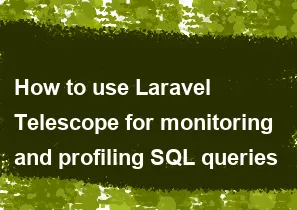How to use Laravel Telescope for monitoring and profiling SQL queries

Laravel Telescope is a powerful debugging and introspection tool for Laravel applications. It allows you to monitor various aspects of your application, including SQL queries. Here's a step-by-step guide on how to use Laravel Telescope to monitor and profile SQL queries:
Step 1: Install Laravel Telescope
You can install Laravel Telescope using Composer. Open your terminal and run the following command:
bashcomposer require laravel/telescope
Then, run the Telescope installation command:
bashphp artisan telescope:install
Finally, run the migrations to create the necessary database tables:
bashphp artisan migrate
Step 2: Configure Your Environment
By default, Telescope is only enabled in the local environment. You can customize this in the TelescopeServiceProvider class. Open App\Providers\TelescopeServiceProvider.php and modify the register method:
phppublic function register()
{
Telescope::ignoreMigrations();
Telescope::filter(function (IncomingEntry $entry) {
// Additional filters if needed
return true;
});
}
Step 3: Accessing Telescope Dashboard
You can access the Telescope dashboard by visiting /telescope in your web browser. If you're running your Laravel application locally, the URL would be something like http://localhost:8000/telescope.
Step 4: Monitoring SQL Queries
Telescope automatically records SQL queries and displays them in the dashboard. You can find them under the "Queries" tab. It provides details like the query, the time it took to execute, and any bindings used.
Additional Links and Resources:
Telescope Documentation:
Video Tutorial:
Blog Posts:
GitHub Repository:
Example:
Let's say you have a controller method that fetches users from the database. Here's an example:
phpuse App\Models\User;
public function index()
{
$users = User::all();
return view('users.index', compact('users'));
}
When you access this route, Laravel Telescope will record the SQL queries involved in fetching the users, and you can view them in the Telescope dashboard.
Remember to remove Telescope from your production environment, as it's intended for development and debugging purposes.
I hope this helps you get started with Laravel Telescope for monitoring and profiling SQL queries!
=== Happy Coding :)
-
Popular Post
- How to optimize for Google's About This Result feature for local businesses
- How to implement multi-language support in an Express.js application
- How to handle and optimize for changes in mobile search behavior
- How to handle CORS in a Node.js application
- How to use Vue.js with a UI framework (e.g., Vuetify, Element UI)
- How to configure Laravel Telescope for monitoring and profiling API requests
- How to create a command-line tool using the Commander.js library in Node.js
- How to implement code splitting in a React.js application
- How to use the AWS SDK for Node.js to interact with various AWS services
- How to use the Node.js Stream API for efficient data processing
- How to implement a cookie parser middleware in Node.js
- How to implement WebSockets for real-time communication in React
-
Latest Post
- How to implement a dynamic form with dynamic field styling based on user input in Next.js
- How to create a custom hook for handling user interactions with the browser's device motion in Next.js
- How to create a custom hook for handling user interactions with the browser's battery status in Next.js
- How to implement a dynamic form with dynamic field visibility based on user input in Next.js
- How to implement a dynamic form with real-time collaboration features in Next.js
- How to create a custom hook for handling user interactions with the browser's media devices in Next.js
- How to use the useSWRInfinite hook for paginating data with a custom loading indicator in Next.js
- How to create a custom hook for handling user interactions with the browser's network status in Next.js
- How to create a custom hook for handling user interactions with the browser's location in Next.js
- How to implement a dynamic form with multi-language support in Next.js
- How to create a custom hook for handling user interactions with the browser's ambient light sensor in Next.js
- How to use the useHover hook for creating interactive image zoom effects in Next.js